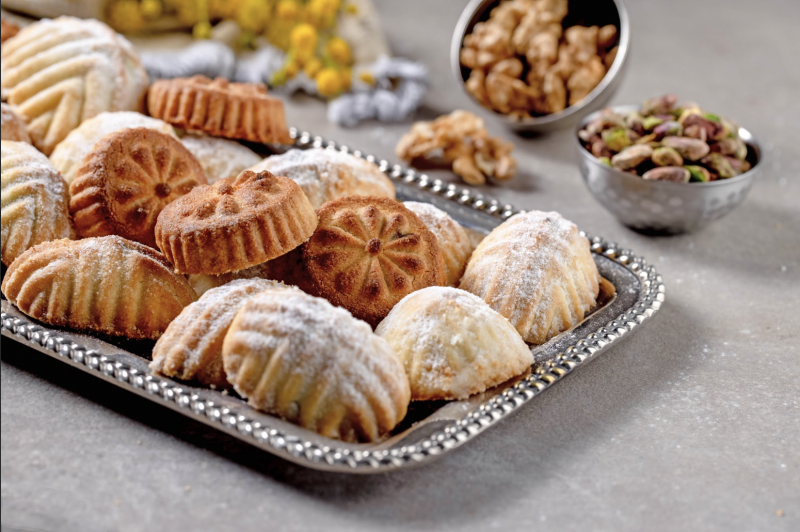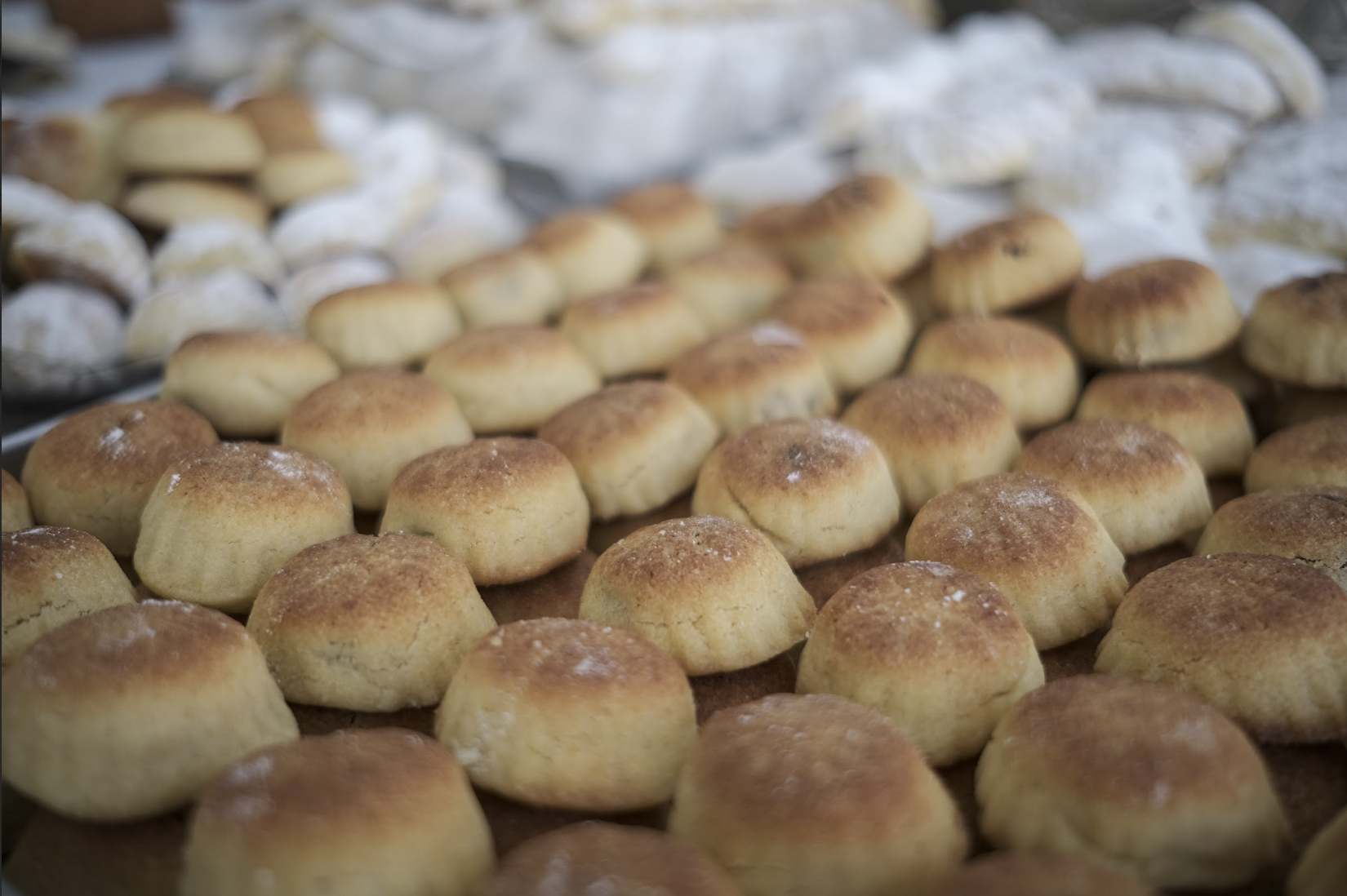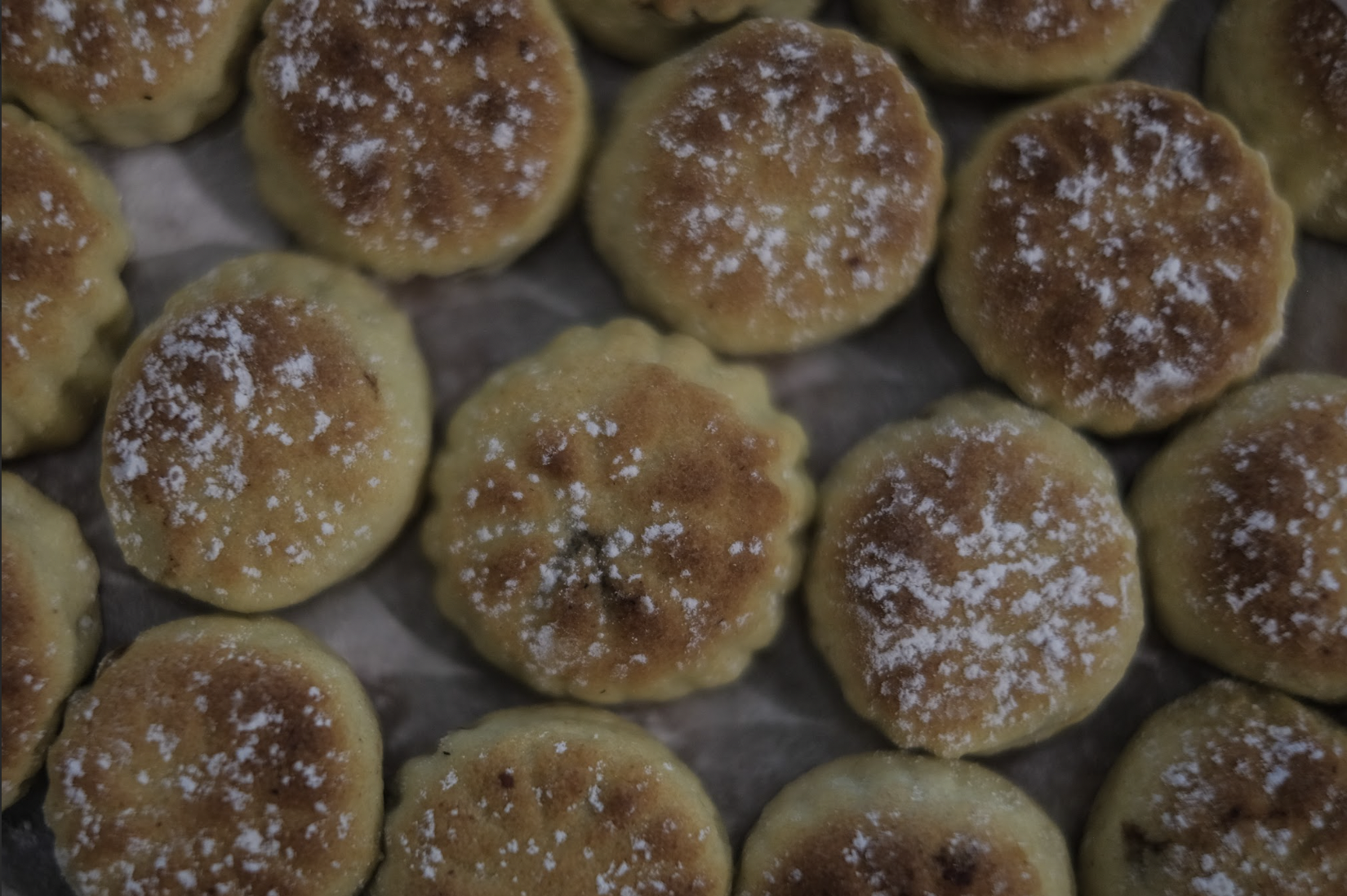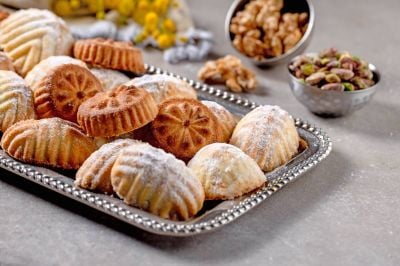
Maamoul served on a silver tray. (Courtesy of: Abdul Rahman Hallab and Sons)
BEIRUT — Pistachios, walnuts and dates — these are the typical fillings of maamoul, Lebanon’s favorite traditional cookie. With its buttery, crumbling semolina shell (sometimes dusted with sugar) and its sensationally sweet and soft filling, variations of this dainty delicacy are on offer in Lebanese homes during nearly all the country’s religious holidays.
For the country’s Christian communities in particular, the traditional treat is associated with Easter and enjoyed after the Lenten fast.
Is maamoul Lebanese?
Let’s start with the name.
“It means to make. It's as simple as that,” says Charles El Hayek, public historian and founder of Heritage and Roots, an initiative sharing insights on Lebanese and Middle Eastern history and heritage.
Next, the ingredients.
“Maamoul reflects the raw material used inside it — nuts, typically walnuts, pistachios, or dates,” says Zaher Hallab, floor manager of the flagship Adbul Rahman Hallab and Sons’ sweets shop in Tripoli. The iconic Lebanese confectionery has been produced by the Hallab family since 1881, first at a simple kiosk in the souk and today throughout its chain of sweet shops across the country and beyond.
“Some variants require less sugar,” Hallab says. “Dates are already sweet, so we put less sugar in those.” Pistachio and walnut variants need more sugar.
“We don’t know the exact history” of maamoul, Hallab concedes.
Its ingredients, along with semolina, Hayek says, have been native to the Levant since the Neolithic period, but maamoul’s origin is “not Lebanese, or even Turkish, or Egyptian” for that matter.
“What we now perceive as historic food has nothing to do with what our ancestors ate because they used different ingredients,” he explains. “The recipes are historical of course but they don’t belong to one country because they were born before the present day map of the Middle East, and because their ingredients change and they are still changing.”
Maamoul, he clarifies, was originally prepared with samneh (ghee). “Now we use butter instead of samneh. The recipe changed.”
Today, one finds all sorts of neo-maamoul varieties. The semolina shells are stuffed with Nutella, dipped in chocolate and whatever other variants suit the modern palate (and perhaps picky children).
 Maamoul displayed at Fouad Doueihy Sweets in Ashrafieh. (Credit: João Sousa/L'Orient Today)
Maamoul displayed at Fouad Doueihy Sweets in Ashrafieh. (Credit: João Sousa/L'Orient Today)
A rich history
Maamoul is as rich in history as it is in flavor.
Some historians believe it is a distant sister of two other ancient Middle Eastern confections — one Pharaonic, the other Mesopotamian (i.e., from ancient Egypt and Iraq).
“The Mesopotamian recipe was called koulloubu [dough and dates], and it survived as the Iraqi ‘kleja,’” Hayek says. In ancient “Egypt it was the kahek — round-shaped date cakes.”
The idea of mixing dough and dates is ancient, and these similar recipes can be traced to the times of the Abbasid Caliphate (750-1258 AD).
“Under Fatimid rule [909-1171 AD] we know that there is something called maamoul al-eid,” Hayek says. “The Fatimid khalif himself would pay for large quantities of maamoul to be made and distributed on Eid al-Fitr.”
The cookies would be stamped with expressions like “kol w shkor” (eat and be grateful).
Sometimes they would stuff the maamoul with gold dinars, Hayek added.
Surely this beats Nutella.
Historians like Hayek believe that today’s much-loved maamoul recipe was likely developed in the Levant during Ottoman rule.
It survives as “kombeh” in Turkey (particularly in southern states that were historically part of Syria) and “maamoul” in Lebanon, Palestine and Syria.
“No country can claim a recipe,” Hayek reiterated. “Recipes are for everyone because food travels. Its identity changes, adopts new ingredients and loses ingredients on its way. Recipes are a living thing.”
 Maamoul waiting to be packaged, Amal Bohsali Sweets, Koraytem. (Credit: João Sousa/L'Orient Today)
Maamoul waiting to be packaged, Amal Bohsali Sweets, Koraytem. (Credit: João Sousa/L'Orient Today)
Preserving heritage
Nowadays, for example, few people in the country still use ghee in their recipes, but some rare producers, like Bohsali sweets in Beirut’s Riad al-Solh square, still do. Operating since 1878, with several locations spreading through the city from the original shop, Bohasali perhaps guards an ancient recipe.
Bohsali and Hallab are Lebanon’s oldest continuously running sweets dynasties, and they offer a taste of history to those who opt to purchase the treat instead of baking it at home.
Across the Levant, maamoul is made from scratch in homes, and recipes are passed on from one generation to the next. This artifact of culinary heritage has been preserved, largely, through matrilineal lines over the centuries.
Some (now rare) individuals, like 17-year-old Maria Khoury, plan to keep the tradition of homemade maamoul alive.
Three years ago, during the COVID-19 lockdown, Khoury (then 14) started her own baking business, ‘Malimou,’ out of her family’s home in Bikfaya.
This year, Khoury made maamoul on her own for the first time. Like in countless Lebanese households, making maamoul at Easter has been a part of family tradition.
“My mom taught me,” Maria explained. “Every year, my mom and my aunts get together, and we make a big batch. We all help out, and everyone takes some home. They learned it from their mothers.”
“Women preserve heritage,” Hayek says. “Because it is sweet, and it takes time, maamoul is the sweet that is typical for Christian Easter and all Islamic holidays like Eid al-Fitr and Adha. It can be preserved for weeks on end because it's baked.”
When asked if she would one day teach her own children how to make maamoul, Khoury emphatically said that she would. Asked if she knew anyone else her age who makes the sweets, or if any of her friends prepare it themselves, she giggles: “No one, actually.”
